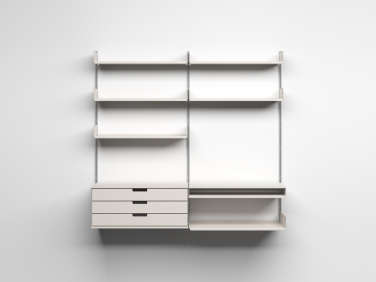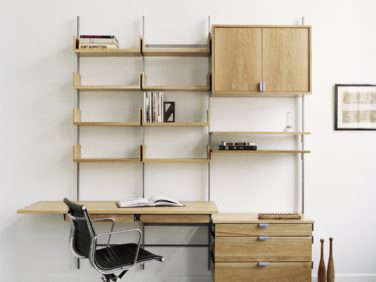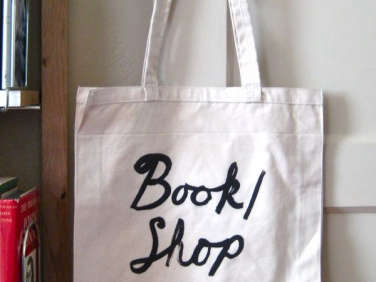We’ve been following self-confessed bookworm Erik Heywood since 2007, when he started Books at Home, a blog devoted to bookshelves. He’s since opened Book/Shop, an online shop where he sells vintage books, furnishings (including our favorite tabletop book shelf), and small goods. We asked Erik to share some of his secrets on living with books; he’s on call to answer any library-related questions you might have. Ask away!
Above: A hand-lettered sign by Erik; the same lettering appears on his Book Bag ($10 from Book/Shop).
Remodelista: When did you become enamored with books?
Erik Heywood: The highest height of my elementary school years was seeing my Weekly Reader order waiting in my cubby, and in 4th grade I was given an award for “Best Use of the Library.” By high school, any of my friends could know for sure they would find me cutting class in the library, or out under a tree with a book open on my face, breathing in the smell as I memorized poetry (I know, I know…).
This is also when I started really noticing the design of books; Faber’s covers from the sixties were especially thrilling to me. I started doodling fake covers at night as my math homework languished. By my twenties I started buying books in earnest and could never resist going into any bookstore I passed (this continues to be true). I would subsist on part-time jobs so I could read eight to ten hours a day. When I moved to New York, I worked in interior design jobs and started Books at Home, a blog about bookshelves. My various jobs allowed me a bit of freedom to roam the city, so I spent a lot of time in libraries and bookshops. The results of this can be seen at Books in New York, a blog I started to catalog book places in the city. I live in the Bay Area now; my house is loaded with beautiful and fascinating books and I’m very happy there.

Above: Erik would have a Flag Halyard chair, designed by Hans Wegner in 1950, in his ideal reading space. Photograph via You Are The River.
RM: Any advice on how to live with books?
EH: Reading books and living with books are slightly different subjects. Some people buy the cheapest edition they can because they just want to read the book. Then they get rid of it. If you want to live with books, you should buy nice editions of books you love. Then you’ll always be happy to see them, the books will add to the beauty of your home, you’ll be more likely to take care of them and want to revisit them. Also, get the least ostentatious but best made shelves you can. It’s best if they’re nearly invisible, letting the beauty of your well-chosen books really stand out.

RM: How do you best care for your books?
EH: Taking care of books is no mystery, just keep them in a condition that you’ll be happy seeing on your shelves. A quick way to make a small space look awful is to fill it with really ratty-looking books, so keep them out of harsh sunlight, don’t pull them off the shelf by the top of the spine (instead push the books on either side back slightly, then hold the book by the middle of the spine and pull it out), and don’t put them in a bag without using one of our Book Sleeves.

Above: A shot of Erik’s bookcase via Instagram.
RM: How do you display/categorize your books?
EH: As much as possible, I organize them by height. Alphabetizing or categorizing them is not needed; even though I have thousands of books, I know exactly where each one is. My design background demands that they get into clean-looking rows. Surprisingly, they tend to naturally fall into categories of their own–art books are naturally bigger, so they end up together, fiction titles tend to run to similar sizes, poetry books tend to be slightly taller than fiction, and so on, but I’m not fanatical about categories, I get much more concerned about heights. Perfecting the height adjustments is a never-ending project that I enjoy.

Above: Vintage copies of The Paris Review.
RM: Any books you are currently coveting?
EH: I’d love a copy of Long Live Great Bardfield & Love to You All, the autobiography of Tirzah Garwood, the Fleece Press’s super-limited-edition and lavishly produced autobiography of the artist who married Eric Ravilious. But at $500 (and with only about 500 copies printed), I’ll probably have to go on coveting for a while.

Above: Albam Modular Shelving. Photograph via Selectism.
RM: Best bookshelves to invest in?
EH: I would be extremely happy to have a carpenter create built-in bookcases like Gio Ponti’s, but of the shelving systems out there, it’s tough to beat the Mogens Koch Shelves from Rud Rasmussen, the 606 from Vitsoe, Atlas Industries as4, Albams’ Utility Shelving, and Enzo Mari’s work for Robots, though we’re prototyping a beautiful system for Book/Shop right now.
Above L: Book Bag; $10. Above R: Absorene Book Cleaner brightens and cleans paper (it’s a favorite of museum curators); $17 from Book/Shop.
RM: Best book find?
EH: One of my happiest finds was Volume 1 of the Lyttelton Hart-Davis Letters, a first edition in wonderful shape at the New York Public Library book sale section (when they had one) at the Mid-Manhattan branch. I knew nothing about it, but it was $2, and a quick glance through it caught my interest. When I started reading it I was instantly hooked. It led me to collect all six volumes of the correspondence, which remains one of my favorite reads. It pays to take chances!

Above: Ofr. bookshop in Paris. Photograph via CIty Notes IO.
RM: Your favorite book stores?
EH: In no particular order (and keep in mind that this list could go on forever):
- The book room at 10 Corso Como in Milan
- San Francisco Book Company in Paris
- 0fr in Paris
- Turtle Island Books in Berkeley
- Moore Used Books in Mendocino
- Ursus, Argosy, and The Strand in NYC
- Oak Knoll Books in Newcastle, Delaware
- Stone Trough Books in York
- Any public library book sale.
Have a book related question? Eric would be happy to answer. Type away….
Check out our recommended Books.
Frequently asked questions
Who is Erik Heywood?
Erik Heywood is a book designer, art director, and principal at the design firm, Book(ish).
What does Erik Heywood do?
Erik Heywood specializes in book design and art direction for clients in publishing, entertainment, nonprofit, and corporate sectors. He is also the founder and principal of Book(ish) Design.
Can Erik Heywood help me design a book?
Yes, Erik Heywood is a book designer and can help you with book design services. You can contact him directly through the website of Book(ish) Design to discuss your project.
What advice does Erik Heywood have for aspiring book designers?
Erik Heywood suggests aspiring book designers to read widely and learn about typography, design history, and bookmaking techniques. He also recommends building a strong portfolio and networking with industry professionals.
What types of projects has Erik Heywood worked on?
Erik Heywood has worked on a variety of projects, including books on art, architecture, photography, fashion, food, and lifestyle. He has also worked on book covers and packaging design for music albums and films.
How does Erik Heywood approach his design process?
Erik Heywood takes an iterative and collaborative approach to his design process. He works closely with clients to understand their vision and goals and creates multiple design concepts to refine and finalize the best solution.









Have a Question or Comment About This Post?
Join the conversation